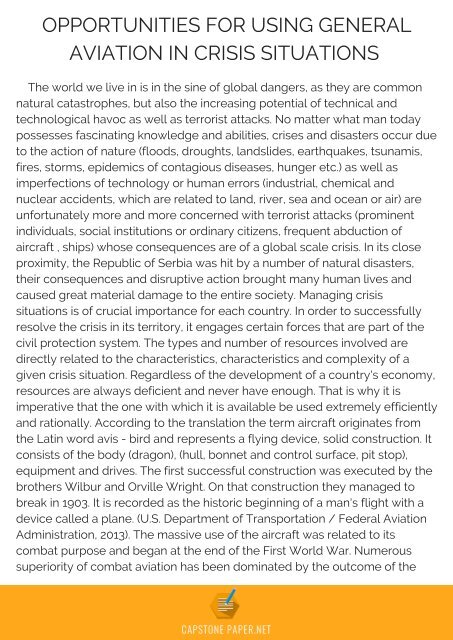Aviation Capstone Project Sample
Hello. Have you seen new aviation capstone project sample? More details https://www.capstonepaper.net/10-best-aviation-capstone-project-ideas/
Hello. Have you seen new aviation capstone project sample? More details https://www.capstonepaper.net/10-best-aviation-capstone-project-ideas/
Create successful ePaper yourself
Turn your PDF publications into a flip-book with our unique Google optimized e-Paper software.
OPPORTUNITIES FOR USING GENERAL<br />
AVIATION IN CRISIS SITUATIONS<br />
The world we live in is in the sine of global dangers, as they are common<br />
natural catastrophes, but also the increasing potential of technical and<br />
technological havoc as well as terrorist attacks. No matter what man today<br />
possesses fascinating knowledge and abilities, crises and disasters occur due<br />
to the action of nature (floods, droughts, landslides, earthquakes, tsunamis,<br />
fires, storms, epidemics of contagious diseases, hunger etc.) as well as<br />
imperfections of technology or human errors (industrial, chemical and<br />
nuclear accidents, which are related to land, river, sea and ocean or air) are<br />
unfortunately more and more concerned with terrorist attacks (prominent<br />
individuals, social institutions or ordinary citizens, frequent abduction of<br />
aircraft , ships) whose consequences are of a global scale crisis. In its close<br />
proximity, the Republic of Serbia was hit by a number of natural disasters,<br />
their consequences and disruptive action brought many human lives and<br />
caused great material damage to the entire society. Managing crisis<br />
situations is of crucial importance for each country. In order to successfully<br />
resolve the crisis in its territory, it engages certain forces that are part of the<br />
civil protection system. The types and number of resources involved are<br />
directly related to the characteristics, characteristics and complexity of a<br />
given crisis situation. Regardless of the development of a country's economy,<br />
resources are always deficient and never have enough. That is why it is<br />
imperative that the one with which it is available be used extremely efficiently<br />
and rationally. According to the translation the term aircraft originates from<br />
the Latin word avis - bird and represents a flying device, solid construction. It<br />
consists of the body (dragon), (hull, bonnet and control surface, pit stop),<br />
equipment and drives. The first successful construction was executed by the<br />
brothers Wilbur and Orville Wright. On that construction they managed to<br />
break in 1903. It is recorded as the historic beginning of a man's flight with a<br />
device called a plane. (U.S. Department of Transportation / Federal <strong>Aviation</strong><br />
Administration, 2013). The massive use of the aircraft was related to its<br />
combat purpose and began at the end of the First World War. Numerous<br />
superiority of combat aviation has been dominated by the outcome of the
Second World War, because who controls the sky that controls the battle<br />
and the territory in which it is led. Aircraft is used for civilian and military<br />
purposes. For civil purposes, they are used for the transport of goods and<br />
passengers, while for military purposes they serve primarily for air space and<br />
airborne activities, as well as for water transport, as well as for transportation<br />
and desant hulls and techniques.<br />
There are four large groups of aircraft engines and they are (U.S.<br />
Department of Transportation / Federal <strong>Aviation</strong> Administration, 2004): Piston<br />
Motors - The thrust of these engines creates a propeller that reverses the air<br />
as a fan and creates the same thrust in the opposite direction. These engines<br />
were characteristic of double wheels and single-lances before the jet<br />
engines. Today, only small planes (lightweight general aviation) use such<br />
engines. Turbocharger Engines - They're similar to piston engines because<br />
they have a propeller, but it is powered by a gas turbine that produces a<br />
direct thrust by throwing out exhaust gases. They are mostly used for aircraft<br />
flying short distances because they are inexpensive. Turbocharged Motors -<br />
These are in fact gas turbines that draw power from burning gasses that<br />
originate from its last end. They are very powerful, but they consume a lot of<br />
fuel and are very loose. There are also versions that have the built-in so<br />
called. The exhaust chamber in which it burns excess fuel in exhaust gases to<br />
increase thrust and provide greater economy. Turbocharger Motors - Used<br />
for most modern airplanes because they combine high power, economical<br />
fuel consumption and relatively low noise levels. According to all the above<br />
data, a general division of aircraft can be made: Traffic Planes: Serves for the<br />
transport of passengers and goods, whereby the transport may be public or<br />
for personal use. General Category of Aircraft: All non-scheduled airplanes<br />
and buses are: Aircraft General Category for Acrobatic Flight, General<br />
Category Aircraft Semi-Robots, General Category Aircrafts for Standard flight.<br />
Special category of aircraft: ("self-construction" or amateur construction,<br />
ultra-light aircraft, experimental aircraft, dragons, etc.). General or general<br />
aviation carries out operations within civil aviation and is conducted as an<br />
improper air transport operation. The flights range from sailing to jet business<br />
aviation. Most of the world's air traffic is part of this category, and most of the<br />
airports in the world are adapted to this type of aviation. (What is General
<strong>Aviation</strong>, 2012). General aviation covers a wide range of commercial and noncommercial<br />
activities, including aero clubs, pilot training centers, agricultural<br />
aviation, light aviation and aeronautics maintenance. (Crane, 1997) Worldwide,<br />
general aviation is most common in North America, with over 6,300<br />
aerodromes tailored to this purpose (of which approximately 5,200 in the US<br />
and over 1,000 in Canada). According to the Aircraft Owners and Pilots<br />
Association (AOPA) data, US general aviation provides more than 1.3 million<br />
jobs, with about 1% of total national income per annum. More than 21,000<br />
civilian aircraft belonging to this category of aircraft have been registered in<br />
the United Kingdom and general aviation is at the very top of providing air<br />
services and activities. (Autority, 2006) Similar information on the wide use of<br />
lightweight general aviation can be obtained anywhere else in the world just<br />
different from country to country, according to its material potentials.<br />
Therefore, it was necessary to harmonize and standardize a large number of<br />
safety regulations and regulations in accordance with the law on air traffic.<br />
(Knecht, 2012).<br />
Most theorists agree that the first decade of the third millennium, decades<br />
of crisis in politics, economics, education, traffic, and energy as well as all<br />
other social activities. The crisis is a companion but also the framework of<br />
modern man's life. And indeed today nothing is as certain as a crisis that has<br />
created the ambience in which an individual, organization or society as a<br />
whole is engaged. In the media, but also in everyday communication people<br />
say the crisis is one of the most commonly used words. It is used in<br />
description of the state, with potentially negative concomitances in which the<br />
society of today is. The crisis today has introduced us into areas of risk<br />
management. We assume that crisis management in the organization is<br />
planning ahead in order to have a good response in all situations and on any<br />
question "what if", that is to say that in the event of a crisis by applying<br />
developed and continuously improved procedures minimized all possible<br />
losses and damaging consequences. the crisis-hit organization will quickly<br />
return to normal. In crisis situations, it is most important to maintain the<br />
organization's continuity and its ability to act. Facing the crisis, only those<br />
organizations that are capable and ready to change can succeed. Turning the<br />
crisis into a chance and mastering it, and succeeding in preserving the key
esources and capabilities of an organization means to be strong. The<br />
organization that is strong is able to "be capable and successful to compete<br />
with change, faster and better than competition". The most successful are<br />
those organizations whose management is not waiting for the problem to<br />
come, but are proactively preparing for it. Management of organization<br />
alongside plan A with which an organization enters the crisis must have a<br />
developed plan B and C and willingness to apply them. Strong organizations<br />
undertake measures and procedures, and develop procedures to become<br />
even stronger, while the weak are surprised and take no action, and the<br />
crises are soon overcome. To understand crisis management in a country's<br />
defense and rescue system, an important aspect is a doctrinal document that<br />
addresses areas of importance for the involvement of state authorities,<br />
business entities and citizens in crisis situations. The protection and rescue<br />
system of the Republic of Serbia is legally regulated by the Constitution, the<br />
National Strategy for Protection and Rescue, the Law on Local Self-<br />
Government, the Law on Fire Protection, Other Legal and By-Laws<br />
(Regulations, Decisions) obligations, signed and ratified international treaties<br />
in this area. By adopting national strategy, protection and rescue by the<br />
Assembly of the Republic of Serbia, basic assumptions have been created for<br />
the timely functioning of state organs, business entities and citizens in crisis<br />
situations and participation in the protection and promotion of people and<br />
material goods, environmental protection and cultural heritage. Depending<br />
on their role, tasks, location and organizational skills of civilian protection is<br />
the most important and fundamental component of the protection and<br />
rescue system. Accordingly, all activities of the civil protection system are<br />
derived from the National Strategy for Protection and Rescue, the principles<br />
of international humanitarian law and international law on the protection of<br />
people and material goods from natural and other disasters as well as from<br />
the assumed international obligations.
REFERENCES<br />
U.S. Department of Transportation/ Federal <strong>Aviation</strong> Administration. (2013).<br />
Glider Flying Handbook. Newcastle, WA: <strong>Aviation</strong> Supplies and Academics,<br />
Inc.<br />
U.S. Department of Transportation/ Federal <strong>Aviation</strong> Administration. (2004).<br />
Airplane Flying Handbook. Newcastle, WA: ASA.<br />
What is General <strong>Aviation</strong> (2012, November 17). Retrieved from AOPA:<br />
http://www.aopa.org/<br />
Crane, D. (1997). Dictionary of Aeronautical Terms. Newcastle, WA: <strong>Aviation</strong><br />
Supplies & Academics, Inc.<br />
Autority, C. A. (2006). Strategic Review of General <strong>Aviation</strong> in the UK. London:<br />
CAA.<br />
Knecht, W. R. (2012). Predicting general aviation accident frequency from pilot<br />
total flight hours. Washington D.C.: DOT/FAA/AM-12/15.

















